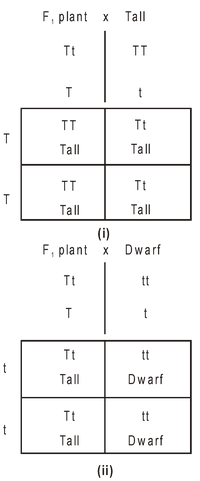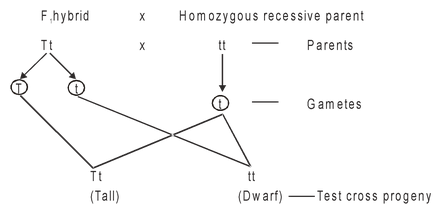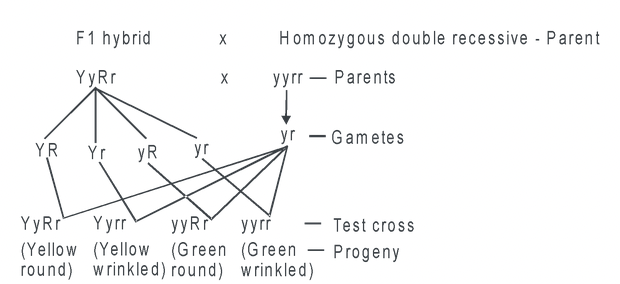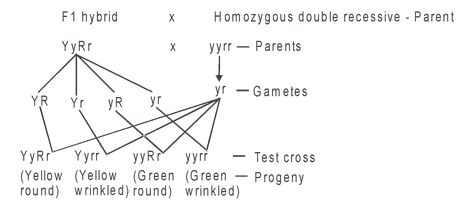Experiments of Mendel
Genetic Basis Of Inheritance of Class 12
Experiments of Mendel
Selection of parents
Mendel selected 7 pairs of pure or true breeding varieties as the starting material for his experiments. On self pollination or self breeding, a pure variety gives rise to offspring having similar trait. e.g., tall variety with tall offspring, a purple flowered variety with purple flowered offspring, etc. Mendel employed seven traits of characters for his experimentation, one from each variety.
Hybridisation for F1 Generation
Mendel performed reciprocal crosses between plants having alternate forms of a trait, tall and dwarf, red flowered and white flowered. In reciprocal crosses pollen of one form were dusted over the stigma of the other form and vice versa, e.g., pollen from flowers of tall plants to emasculated flowers of dwarf plants and pollen from flowers of dwarf plants to emasculated flowers of tall plants. The hand pollinated flowers were covered with paper bags in order to avoid contamination from foreign pollen. The cross in which only two alternate forms of a single trait or character are taken into consideration is called monohybridcross. Mendel also performed crosses involving two characters. They are called dihybrid crosses. Trihybrid and polyhybrid crosseswere performed as well. The seeds of the cross or crosses were collected and sown next year. The hybrid offspring including the seeds constitute the nextgeneration termed first filial or F1 generation.
Self Breeding for F2 and F3 Generations
The plants of F1 generation were allowed to covered with paper bags from the beginning. Mendel collected the seeds and raised a new generation of plants. The seeds and plants raised from them constitute the second final or F2 generation. Further self pollination produced F3 or third fillial generation. Mendel kept record of each generation and observed as follows.
Monohybrid Cross
When only a single pair of contrasting or differentiating characters is considered in a cross (or inheritance of only one pair of contrasting characters is studied in a cross), it is called monohybrid cross, e.g. ;

Fig: Monohybrid cross
Phenotypic ratio in F2 gen. of monohybrid cross = 3 : 1 (Tall) (Dwarf)
Genotypic ratio in F2 gen. of monohybrid cross = 1 : 2 : 1 (Pure tall) (Hybrid tall) (Dwarf)
The two forms of the trait appear in F2 generation in ratio of three dominant to one recessive, 3 : 1. It is also called monohybrid ratio. For example, in the character of height (cross tall X dwarf) Mendel obtained 787 tall and 277 dwarf plants (ratio 2.84: 1). A similar result for flower colour was 705 violet to 224 white (ratio 3.15 : 1).
Reciprocal Cross
Similar results were obtained with reciprocal crosses also. A reciprocal crosses involves the same traits but carried by sexes opposite to those in the original or first cross.
Back Cross
When F1 individual (Tt) is crossed with one of the two parents, either tall (TT) or dwarf (tt), such a cross is called the back cross.
There are two possibilities in such a cross :
- When F1 (Tt) is crossed with the dominant homozygous (TT) parent, the plants produce will be 100% tall.
- If F1 (Tt) is crossed with recessive homozygous (tt), 50% plants will be tall and 50% dwarf.

Uses of a Back Cross
Back crosses are used by plant breeders to rapidly improve a variety by making a useful trait (gene) homozygous, that is pure.
Test Cross
Crossing of F1 hybrid with its homozygous recessive parent is called test cross and the progeny of test cross is called test cross progeny.
Monohybrid Test Cross

Fig: Monohybrid Test Cross
Thus, monohybrid test cross ratio = 1 : 1
Dihybrid Test Cross

Fig: Dihybrid Test Cross
So dihybrid test cross ratio = 1 : 1 : 1 : 1
Trihybrid Test Cross
It involves crossing of a trihybrid (Rr Yy Cc) with triple recessive (rr yy cc). The eight different phenotypes will be obtained in 1 : 1 : 1 : 1 : 1 : 1 : 1 : 1 ratio.
Uses of a Test Cross
The test cross reveals the genotype of an organism displaying the dominant phenotype, hence its name.
Results of Monohybrid Crosses
Mendel got the following results from his monohybrid crosses :
- F1 plants produced by a cross between two plants pure for the contrasting traits of a character are similar and express only one contrasting trait, i.e; resemble only one parent. None is intermediate between the two alternative traits of parents.
- It does not matter which parent provides male gamete and which provides female gamete, the results remain the same. In other words, the reciprocal crosses produce similar F1 plants.
- Both the contrasting traits appear in the F2 plant.
- The contrasting trait of a character expressed in F1 plants appears in three–fourths of the F2 plants.
- One of the two contrasting traits of a character remains unexpressed (hidden) in F1 generation.
Conclusions Drawn from the Monohybrid Crosses
From the results of his monohybrid crosses, Mendel found out the following conclusions :–
Conclusions Drawn from the Monohybrid Crosses
From the results of his monohybrid crosses, Mendel found out the following conclusions :–
- Principle of Unit or Paired Factors (Postulate 1) : A character is represented in an organism (diploid) by at least two factors. The two factors lie on the two homologous chromosomes at the same locus. They may represent the same (homologous, e.g; TT in case of pure tall Pea plants) or alternate expression (heterozygous, e.g; Tt in case of hybrid tall Pea plants) of the same character. Factors representing the alternate or same form of a character are called alleles or allelomorphs.
- Principle of Dominance (Postulate 2) : It states, “When a pair of alleles or allelomorphs are brought together in F1 hybrid, then only one of them expresses itself, masking the expression of other completely.” e.g; In Tt–F1 hybrid is tall Only ‘T’ expresses itself – so dominant and ‘t’ is masked – so recessive.
- Principle of Segregation or Principle of Purity of Gametes (Postulate 3) : It states that, “When a pair of alleles or allelomorphs are brought together in F1 hybrid, they remain together (coexist) without mixing or contaminating or blending with each other and separate complete and pure during formation of gamete (gametogenesis).” It is also known as ‘Law of purity of gametes’ because each gamete is pure in itself, i.e; having either T (i.e; gene for tallness) or t (i.e; gene for dwarfness).
Important Prediction
In his law of Segregation, Mendel predicted the occurrence of meiosis, long before it was discovered.
Dihybrid Crosses
Such a cross in which two pairs of contrasting characters are taken into consideration simultaneously, is called dihybrid cross, e.g; cross between pea variety having yellow cotyledons and round (smooth) seeds with another variety having green cotyledons and wrinkled seeds.

Fig: Dihybrid cross
So in F2 generation of dihybrid cross :
- Phenotypic ratio : 9 : 3 : 3 : 1 [Yellow round] [Yellow wrinkled] [Green round] [Green wrinkled]
- Genotypic ratio : 1 : 2 : 2 : 4 : 1 : 2 : 1 : 2 : 1
Results of a Dihybrid Cross
Mendel got the following results from his dihybrid cross :–
- Four types of Plants : A dihybrid cross produced four types of plants in F2 in the ratio of 9 with two dominant traits, 3 with one dominant and one recessive trait, 3 with the other dominant and other recessive trait, and 1 with two recessive traits.
- New Combinations : Two new combinations of traits : round green and wrinkled yellow, had appeared in a dihybrid cross.
Conclusion drawn from a Dihybrid Cross
From the F2 generation of a dihybrid cross, Mendel concluded as under :–
- Law of Independent Assortment (Postulate 4) : It states, “When two pairs of independent alleles are brought together in F1 hybrid, they show independent dominant effects, in the formation of gametes law of segregation occurs and the factors (genes) assort themselves independently, at random and freely.”
- Probability of the F2 Genotypes and Phenotypes of a Dihybrid Cross : The nine genotypes of F2 generation for the two genes are the products of three genotypes for each gene as shown below :
| Gene 1 | Gene 2 | Probabilities of genotypes and phenotypes |
| 1/4 RR | X 1/4 YY | = 1/16 RRYY Round Yellow |
| 2/4 Yy | = 2/16 | RRYy Round Yellow |
| 1/4 Yy | = 1/16 | RRYy Round Green |
| 2/4 Rr | X 1/4 YY = 2/16 | RRYy Round Yellow |
| 2/4 Yy | = 4/16 | RRYy Round Yellow |
| 1/4 Yy | = 2/16 | Rryy Round Green |
| 1/4 rr | X 1/4 YY = 1/16 | rrYY Wrinkled Yellow |
| 2/4 Yy | = 2/16 | rrYy Wrinkled Yellow |
| 1/4 yy | = 1/16 | rryy Wrinkled Green |
F2 Phenotypes
The probabilities of the F2 phenotypes of a selfed F1 dihybrid is a product of the probabilities of the separate selfed F1 monohybrid phenotypes i.e; 3/4 : 1/4
| Gene 1 | Gene 2 | Probabilities of genotypes and phenotypes |
| 3/4 Round | X 3/4 Yellow | = 9/16 Round Yellow |
| 1/4 Green | = 3/16 | Round Green |
| 1/4 Wrinkled X | 3/4 Yellow = | 3/16 Wrinkled Yellow |
| 1/4 | Green = 1/16 | Wrinkled Green |
These 9 : 3 : 3 : 1 ratios for the pairs of traits are independent of one another and that combinations turn up as expected according to chance.
Mendel’s Trihybrid Cross
Using Mendel’s peas, a cross may be arranged between a variety with yellow round seeds and red flowers (RR YYCC) and a variety with green–wrinkled seeds and white flowers (rryycc). Their gametes will contain the genes RYC and ryc and the heterozygous (trihybrid), F1 will be RrYyCc. Because of dominance, it will have round–yellow seeds and red flowers.
Given an independent assortment of the genes, this hybrid will produce eight kinds of gametes as follows :
- RYC
- RYc
- RyC
- Ryc
- rYC
- rYc
- ryC
- ryc
In the F2 generation, produced by random union, these eight kinds of gametes, there will evidently be 64 possible combinations, as can be seen by constructing a checker board, representing the trihybrid cross
The eight phenotypically different kinds of peas will appear with approximately the following frequencies:
- 27 Round –Yellow – Red
- 9 Round – Yellow – White
- 9 Round – Green – Red
- 9 Wrinkled – Yellow – Red
- 3 Round – Green – White
- 3 Wrinkled – Yellow – White
- 3 Wrinkled – Green – Red
- 1 Wrinkled – Green – White









